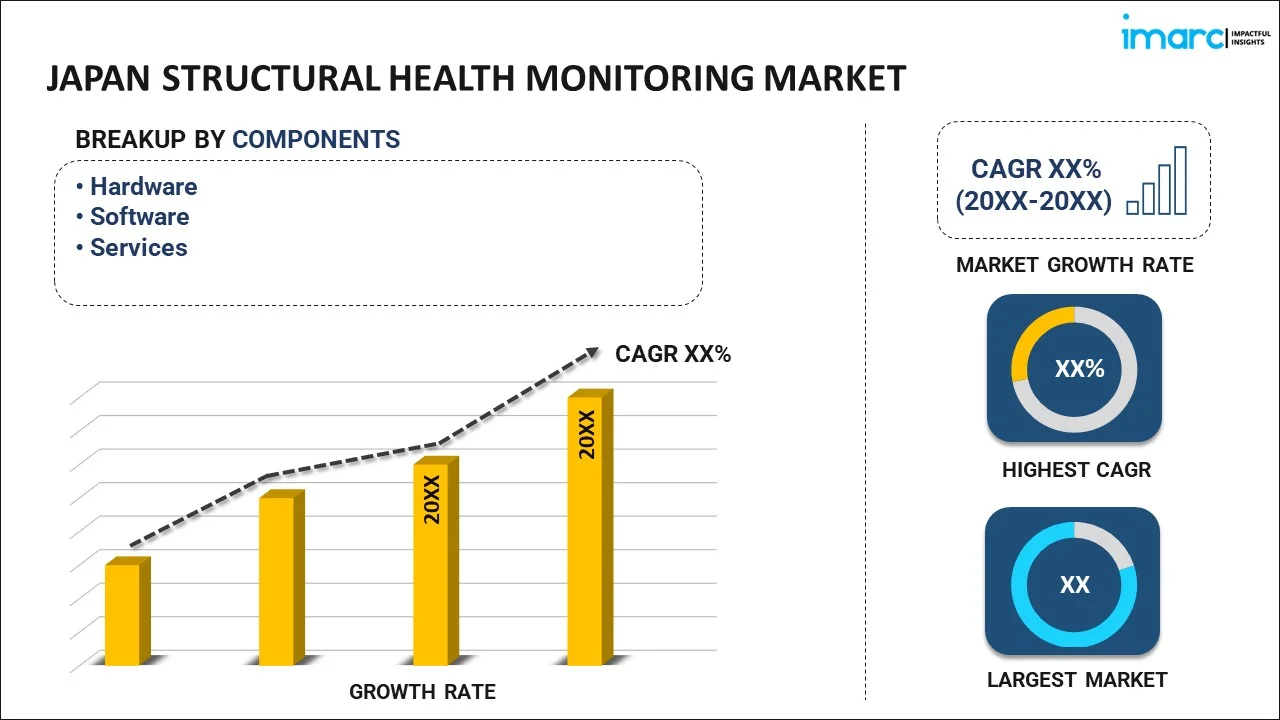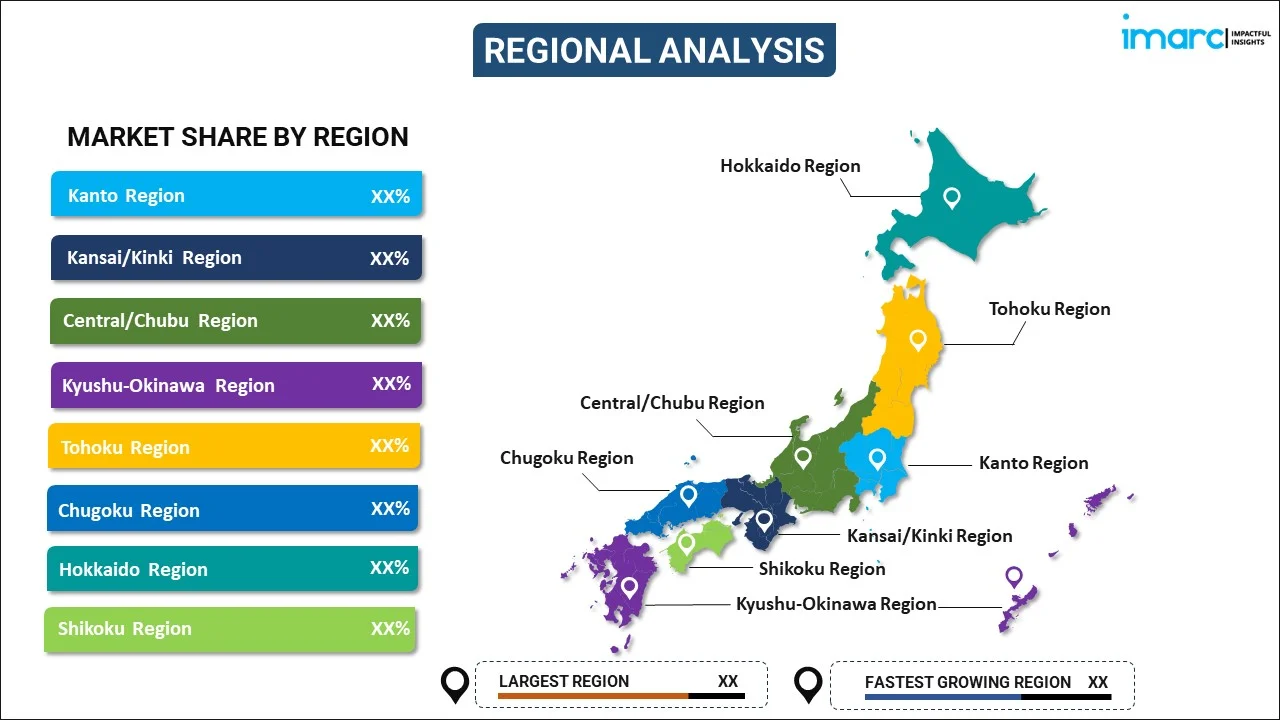
Japan Structural Health Monitoring Market Report by Component (Hardware, Software, Services), Technology (Wired, Wireless), Implementation Method (New Construction, Retrofitting), Vertical (Civil Infrastructure, Aerospace and Defense, Energy, Mining, and Others), and Region 2026-2034
Market Overview:
Japan structural health monitoring market size reached USD 160.5 Million in 2025. Looking forward, IMARC Group expects the market to reach USD 457.6 Million by 2034, exhibiting a growth rate (CAGR) of 12.35% during 2026-2034. The growing need among government bodies for enhancing public safety and preserving historical monuments is primarily driving the market growth.
|
Report Attribute
|
Key Statistics
|
|---|---|
|
Base Year
|
2025
|
|
Forecast Years
|
2026-2034
|
|
Historical Years
|
2020-2025
|
| Market Size in 2025 | USD 160.5 Million |
| Market Forecast in 2034 | USD 457.6 Million |
| Market Growth Rate 2026-2034 | 12.35% |
Structural health monitoring (SHM) is the process of systematically monitoring and inspecting various types of 3D structures, including those in aerospace, civil engineering, mechanical engineering, and infrastructure, with the goal of identifying faults and irregularities. This monitoring involves the deployment of multiple sensors that continuously gather data throughout the structure's operational lifespan. SHM relies on non-destructive techniques such as acoustic emission, ultrasonic testing, and thermal imaging to detect any abnormalities resulting from factors like deterioration, construction errors, inadequate quality control, or excessive accidental or environmental loads. Structural health monitoring has broad applications across various industries, including the assessment of bridges, power generation facilities, wind energy plants, water and gas pipelines, tunnels, offshore rigs, and road pavements. Additionally, it plays a crucial role in identifying wear and malfunctions, whether internal or external, in marine vessels, aircraft, and heavy commercial vehicles.
Japan Structural Health Monitoring Market Trends:
In the context of the Japanese market, the growth of structural health monitoring (SHM) is significantly propelled by the increasing need for standardization and automation in the maintenance and repair of civil and infrastructure projects. With the rapid digitization and the emergence of smart sensor technologies, SHM has become a prevalent tool in the design, analysis, and upkeep of modern civil engineering structures and systems. Contractors now have the capability to employ SHM solutions for remotely overseeing construction processes, thereby ensuring quality control. Moreover, technological advancements, including the integration of innovative communication modules and data acquisition systems for information processing and analysis, are key drivers of market expansion. These advanced solutions allow consumers to incorporate a wide range of variables, including electrical, magnetic, thermal, physical, and chemical factors, which enhance the analysis of structural health. Additionally, the implementation of favorable government policies aimed at enhancing public safety, coupled with extensive infrastructural development initiatives, particularly in emerging economies, are expected to contribute significantly to market growth in Japan over the forecasted period.
Japan Structural Health Monitoring Market Segmentation:
IMARC Group provides an analysis of the key trends in each segment of the market, along with forecasts at the country level for 2026-2034. Our report has categorized the market based on component, technology, implementation method, and vertical.
Component Insights:

- Hardware
- Software
- Services
The report has provided a detailed breakup and analysis of the market based on the component. This includes hardware, software, and services.
Technology Insights:
- Wired
- Wireless
A detailed breakup and analysis of the market based on the technology have also been provided in the report. This includes wired and wireless.
Implementation Method Insights:
- New Construction
- Retrofitting
The report has provided a detailed breakup and analysis of the market based on the implementation method. This includes new construction and retrofitting.
Vertical Insights:
- Civil Infrastructure
- Aerospace and Defense
- Energy
- Mining
- Others
A detailed breakup and analysis of the market based on the vertical have also been provided in the report. This includes civil infrastructure, aerospace and defense, energy, mining, and others.
Regional Insights:

- Kanto Region
- Kansai/Kinki Region
- Central/ Chubu Region
- Kyushu-Okinawa Region
- Tohoku Region
- Chugoku Region
- Hokkaido Region
- Shikoku Region
The report has also provided a comprehensive analysis of all the major regional markets, which include Kanto Region, Kansai/Kinki Region, Central/ Chubu Region, Kyushu-Okinawa Region, Tohoku Region, Chugoku Region, Hokkaido Region, and Shikoku Region.
Competitive Landscape:
The market research report has also provided a comprehensive analysis of the competitive landscape in the market. Competitive analysis such as market structure, key player positioning, top winning strategies, competitive dashboard, and company evaluation quadrant has been covered in the report. Also, detailed profiles of all major companies have been provided.
Japan Structural Health Monitoring Market Report Coverage:
| Report Features | Details |
|---|---|
| Base Year of the Analysis | 2025 |
| Historical Period | 2020-2025 |
| Forecast Period | 2026-2034 |
| Units | Million USD |
| Scope of the Report | Exploration of Historical and Forecast Trends, Industry Catalysts and Challenges, Segment-Wise Historical and Predictive Market Assessment:
|
| Components Covered | Hardware, Software, Services |
| Technologies Covered | Wired, Wireless |
| Implementation Methods Covered | New Construction, Retrofitting |
| Verticals Covered | Civil Infrastructure, Aerospace and Defense, Energy, Mining, Others |
| Regions Covered | Kanto Region, Kansai/Kinki Region, Central/ Chubu Region, Kyushu-Okinawa Region, Tohoku Region, Chugoku Region, Hokkaido Region, Shikoku Region |
| Customization Scope | 10% Free Customization |
| Post-Sale Analyst Support | 10-12 Weeks |
| Delivery Format | PDF and Excel through Email (We can also provide the editable version of the report in PPT/Word format on special request) |
Key Questions Answered in This Report:
- How has the Japan structural health monitoring market performed so far and how will it perform in the coming years?
- What has been the impact of COVID-19 on the Japan structural health monitoring market?
- What is the breakup of the Japan structural health monitoring market on the basis of component?
- What is the breakup of the Japan structural health monitoring market on the basis of technology?
- What is the breakup of the Japan structural health monitoring market on the basis of implementation method?
- What is the breakup of the Japan structural health monitoring market on the basis of vertical?
- What are the various stages in the value chain of the Japan structural health monitoring market?
- What are the key driving factors and challenges in the Japan structural health monitoring?
- What is the structure of the Japan structural health monitoring market and who are the key players?
- What is the degree of competition in the Japan structural health monitoring market?
Key Benefits for Stakeholders:
- IMARC’s industry report offers a comprehensive quantitative analysis of various market segments, historical and current market trends, market forecasts, and dynamics of the Japan structural health monitoring market from 2020-2034.
- The research report provides the latest information on the market drivers, challenges, and opportunities in the Japan structural health monitoring market.
- Porter's five forces analysis assist stakeholders in assessing the impact of new entrants, competitive rivalry, supplier power, buyer power, and the threat of substitution. It helps stakeholders to analyze the level of competition within the Japan structural health monitoring industry and its attractiveness.
- Competitive landscape allows stakeholders to understand their competitive environment and provides an insight into the current positions of key players in the market.
Need more help?
- Speak to our experienced analysts for insights on the current market scenarios.
- Include additional segments and countries to customize the report as per your requirement.
- Gain an unparalleled competitive advantage in your domain by understanding how to utilize the report and positively impacting your operations and revenue.
- For further assistance, please connect with our analysts.
 Request Customization
Request Customization
 Speak to an Analyst
Speak to an Analyst
 Request Brochure
Request Brochure
 Inquire Before Buying
Inquire Before Buying




.webp)




.webp)












